| OCR Text |
Show temperature. More detailed measurements, in particular, integrated time samples, need to be taken before results can be fully explained, but it appears that for low contaminant loading, at high temperatures , the toluene is combusted in the kiln. At higher loadings, 10% to 50%, the toluene might fonn soot, as previously reported (6). At the end of the run, for all temperatures the concentration of toluene in the sorbent was below 5 J..Lg/gm. Finally, contaminant concentration appears to have an interesting effect as shown in Figure 14. For the higher concentration, 2%, the mass flow rate of toluene was initially the same as the 1 %, but then decreased significantly during the peak burning period. The C02 concentration data show more CO2 at the higher concentration for a longer time, then at 1 % concentration. It appears that the higher initial-contarninant concentration produced a larger initial evolution rate and this caused more toluene to bum within the kiln, but again, more detailed measurements will have to be taken to confmn these predictions and qualify the formation of PICs and soot Kiln Modeling An exact model of a rotary kiln is not currently available because the geometry is three-dimensional and the fluid mechanics, heat transfer, mass transfer, and chemical reactions are all coupled with at least three characteristic time scales: gas phase reactions (ms), gas phase residence time (sec), and solid phase residence time (hrs). The approach used in this modeling effort was not to attempt a full three-dimensional solution of the coupled problem, but rather to construct a modular model containing three parts: fluid mechanics, heat transfer, and bed mass transfer/chemical reaction. The bed and heat transfer submodels are coupled numerically. At present, direct coupling of the fluid and heat transfer models is not possible due to their different fonnulations. The fluid mechanics calculation is two-dimensional, while the radiation portion of the heat transfer model is fully three-dimensional to account for the asymmetric heat transfer which occurs due to the reacting bed positioned across the bottom of a horizontal cylinder. The overall concept of the model is shown in Figure 15. The fluid mechanics submodel solves the steady-state, two-dimensional NavierStokes equations in conjunction with homogeneous, gas-phase reaction kinetics and adiabatic energy balances. The solution provides information on flame length, flame diameter, entrainment rates, and oxygen concentration profiles, all of which are important parameters in the other two submodels. The heat transfer submodel divides the kiln axially into zones as shown in Figure 15. The different surfaces within a zone are characterized by their separate, isothermal temperatures. Within a zone radial temperature gradients in the gas and the flame are neglected. Radiation exchange is permitted between the surfaces of immediately adjacent lones. Energy balances are performed on the gas, flame, and bed solids. The bed solids are assumed to be uniform in temperature due to the bed stirring, a result of the kiln rotation. The heat-transfer model requires the specification of flame size and burning rate, which are both available from the fluid flow model. The energy balance on the bed solids accommodates energy generation due to combustion of bed solids and includes provisions to account for the energy required to evaporate water from the contaminated solid bed. Heat transfer from the kiln wall is also considered. The modeling efforts from the Particle Characterization Reactor and Bed Characterization Reactor will be coupled with the heat transfer model to provide information on the evolution of contaminant from the bed. |




























